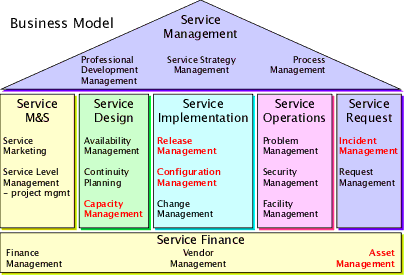| q-Status™ and Sun IT Processes Comparison |
|
Question:
How does q-Status™ Configuration Management compare to the following types of Sun Microsystems IT Processes?
- Asset Management
- Patch Management
- Reporting (e.g. Teamquest)
- Monitoring (SunMC)
- Computing on Demand.
Response:
A principal concept in Information Technology Infrastructure Library (ITIL) is the Configuration Item Database or the CIDB. All the above tools create and define a CIDB’s. Unfortunately because the word “database” is used in the ITIL definition, there is misconception that all these tools could be consolidated under one database process. This is theoretically impossible because each process defines it's own set of requirements for an effective structure of a collection process for it's ITIL function. For example, Microsoft's Word is not an effective web authoring or image editing tool, since its structure is not efficient in these processes.

- q-Status™ is a configuration management tools. It structure was built to conform to ITIL definition of Configuration Management which falls under the ITIL Service Implementation processes. A configuration management tool should not only show the user what configuration items they have, but provide the user with comparisons and analysis. This includes cross type comparisons, baseline comparisons and comparisons against a set of parameters.
- The first item on the list is the Asset Management tool. It falls under the ITIL Service Finance process. This Finance process is a business process and not a Service Implementation process. The requirements and structures for an efficient and effective financial process are different than for service implementation process. In companies that have attempted to use an Asset Management tool to also support configuration management, a great deal of resources and manpower have been expended to utilize a poorly designed structure for configuration management from a tool that has a great design for financial asset management. One of the advantages of q-Status™ is it simple process to collect data which is easily understood and maintained and used by the primary user-the system administrator.
- Patch Management falls under ITIL Release Management which is also classified in Service Management along with Configuration Management. Hence Patch Management is more closely related to Configuration management than Asset Management because they belong to the same major process. Patch Management depends on a specific vendor process for its support. For Sun Microsystems there are a multitude of Sun tools available (e.g. patchdiag.xref, Griffin, Sun Checkup, and smpatch). All these tools generate different results and have different capabilities. Vendor tools that perform patch management have been developed as part of the ITIL process called Release Management, not Configuration Management. They provide little capability to perform any type of Configuration analysis or comparison. Because q-Status™ is a built as a configuration management tool, it has built-in comparisons and historical evaluations of patch configurations. q-Status™ Configuration Management has not been designed as a Release Management Tool, but it has been designed to support Release Management Tools by generating patch list sets that can be used by the Release Management Tool.
- The next two tools on the list, Teamquest and SunMC, fall under two ITIL processes: Capacity Planning and Incident Management. The first supports the Service Design function. The second supports the Service Request function. q-Status™ has not been designed to support either of these functions. There are some features in q-Status™ such as the identification of single points of failure and failed disk configurations. But Service Design Tools and Service Request tools do a more timely and better job. SunMC does have some configuration management reporting as does Teamquest, but because they are built as a Capacity Management and Incident Management tools, their design does not support effective or full configuration management. SunMC only works on Sun.
- The last item, Computing On Demand (COD), is a vendor specific process that is classified under the ITIL Service Design process as a Capacity Management( or Planning) Tool. Relating q-Status™ to COD items by adding them to the tool, may be of interest, but this has never been requested. LogiQwest would more than happy to entertain such a requirement within the configuration management process (e.g. COD un-enabled items). In no way should q-Status™ be consider a COD tool as it is in the wrong classification.
|
|
|
|